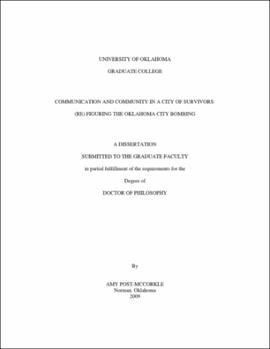| dc.contributor.advisor | Sandel, Todd | |
| dc.creator | Post-McCorkle, Amy Delois | |
| dc.date.accessioned | 2019-06-03T20:35:51Z | |
| dc.date.available | 2019-06-03T20:35:51Z | |
| dc.date.issued | 2009 | |
| dc.identifier | 9941801302042 | |
| dc.identifier.uri | https://hdl.handle.net/11244/320224 | |
| dc.description.abstract | This is an ethnographic study on the Oklahoma City bombing survivor community. The purpose of this study is to examine survivor, volunteer, and rescuer accounts gathered through field notes, interview, and archival documents, in order to understand the survivor community of the Oklahoma City bombing. The Oklahoma Standard, conceptually, represents the goodness displayed by the citizens of Oklahoma City in a time of crisis. The term represents the incredible outpouring of love and support or response of the Oklahoma City community as coined by FEMA (Federal Emergency Management Agency). The Oklahoma Standard, as a metaphor, serves as the orienting construct for the Oklahoma City bombing survivor community. As a metaphor, the Oklahoma Standard is in process. It is dynamic. It is ever-changing. The Oklahoma Standard represents not only the immediate response of the community but also the continual response in that the Oklahoma Standard is now (after 9/11 World Trade Center) the idea of communities that have experienced a crisis helping other communities in crisis. Many communities experience crises whether natural or unnatural and respond accordingly. However, the interesting thing about the Oklahoma City bombing survivor community is that they are still responding to a crisis today. The continual response by the Oklahoma City bombing survivor community is what sets it apart from other survivor communities. The Oklahoma Standard went from an immediate response to a continual response in that we now see a community that has experienced a major crisis helping other communities in crisis, helping them to heal and move on. | |
| dc.description.abstract | This paper identified the interaction between communication and community among the survivors of the Oklahoma City bombing. The crisis forced people to redefine themselves and to find out who they were in a reconstructed world. The weakening of traditional forms of community led human kind in search of alternative types of community that will provide them with a sense of belonging to a particular group or place. Symbolic meaning and collective memory results from everyday communication practices; hence, constructing the framework for building a "new-style community": Ultimately (re) figuring the reality of the tragedy into the everyday lives of the survivors. | |
| dc.format.extent | 264 pages | |
| dc.format.medium | application.pdf | |
| dc.language | en_US | |
| dc.relation.requires | Adobe Acrobat Reader | |
| dc.subject | Communication--Social aspects | |
| dc.subject | Communication--Psychological aspects | |
| dc.subject | Disasters--Psychological aspects | |
| dc.subject | Oklahoma City Federal Building Bombing, Oklahoma City, Okla., 1995 | |
| dc.title | Communication and Community in a City of Survivors: (Re) Figuring the Oklahoma City Bombing | |
| dc.type | text | |
| dc.type | document | |
| dc.thesis.degree | Ph.D. | |
| ou.group | College of Arts and Sciences::Department of Communication | |
